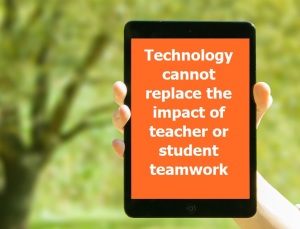
The integration of technology into the hands of your students has likely been a topic of much discussion, but it will never replace the importance of teacher teamwork or the environment that a quality classroom provides.
Whether by laptops, I-pads, smart-boards, or smart phones, your classroom has in all likelihood already been invaded by technology.
And that is not a bad thing.
While, as a teacher, you may marvel at the capabilities these tools bring to your classroom, technology is still just exactly that – simply a collection of shiny new tools.
Still, it is true that the right tools can make any job easier.
If I were building a house, I would prefer to have a shiny new nail gun instead of the hammer my grandfather had to use.
Similarly, education is certainly made easier when we find ways to engage students in interesting ways to share information and skills. But tools are not the goal.
Tools are a vehicle by which we help students to reach the destination of skills and knowledge we have identified. Teachers have access to a staggering and still increasing array of technology and online resources, but it is the relationship and communication they share with their peers that likely gives them the energy and morale to provide their students with creative ideas or content discovery activities that inspire an infectious enthusiasm.
Technology allows us to enjoy and find more connections – but we must have interpersonal skills
Seth Godin, in his self-published manifesto on education, “Stop Stealing Our Dreams,” writes that we are no longer in the “industrial revolution” and should now teach according to the needs and relevancy of the current “connection revolution.”
Nowhere is this more important to acknowledge than in American schools, where students are too often still isolated in rows and columns and tested with scantrons because their teachers are too often still isolated in rooms and evaluated by standardized test scores.
The most powerful activity for student or teacher learning is active collaboration, and while technology is certainly a useful tool to connect people and allows yet another avenue for sharing and conversation to take place, it is not an answer to teacher teamwork, but an encouragement for more of what has ever been the backbone of strong school culture – teachers sharing information, ideas, and activities that they have seen actively engage students and create enjoyable learning experiences.
Further, while experiential learning has been proven to engage students and produce a significantly higher degree of understanding and retention, group work and student collaboration are more often greeted with scowls that allege cheating instead of smiles that encourage collaborating.
An article from over ten years ago found in Educase Quarterly described a very successful integration of technology and teamwork into a college classroom at Northern Michigan University, but even that study concluded that “the belief that a computer-literate generation will automatically adopt and thrive in a technology-rich educational environment is, we believe, a myth. Just because more of today’s students have computing experience doesn’t mean they know how to use computers effectively in their education.”
It was the emphasis placed on building teamwork, through face to face and interpersonal skills, that was commented on as being perhaps the most significant contributor to their success.
Teachers can perhaps best become comfortable with providing opportunities for student collaboration if they are encouraged to grow and given a simple tool for collaborating with their teaching peers, who likely each have a treasure chest of activities they have not been asked to share as ideas others might want to incorporate or adapt.
As Seth Godin’s manifesto suggests, technology provides the tools to share with more people more quickly and easily than at any time in our existence, but a school’s culture is not determined by the number of laptops it has available for student usage.
Culture trumps strategy in any organization – whether academic, athletic, or corporate.
Because teacher morale and collaboration are perhaps the greatest determiners of a quality school culture, and students’ overall academic performance is a symptom of that culture, it is important to prioritize your resources to have the most positive impact.
An emphasis on growing teacher and student comfort with using technology to connect and share will continue to grow in popularity, but it may prove beneficial to remember that the collection of technology you receive are only tools to improve instruction – and using those tools effectively is largely the result of enabling and encouraging more student and teacher teamwork.
If your people have enough technology,and still need better communication, leadership skills, or a boost of morale, perhaps you want to consider an event to improve team motivation. Your staff will have a great time, share some laughter, and the impact on your school culture will be amazing!
You can also like Sean on Facebook or choose to follow Sean on twitter!
